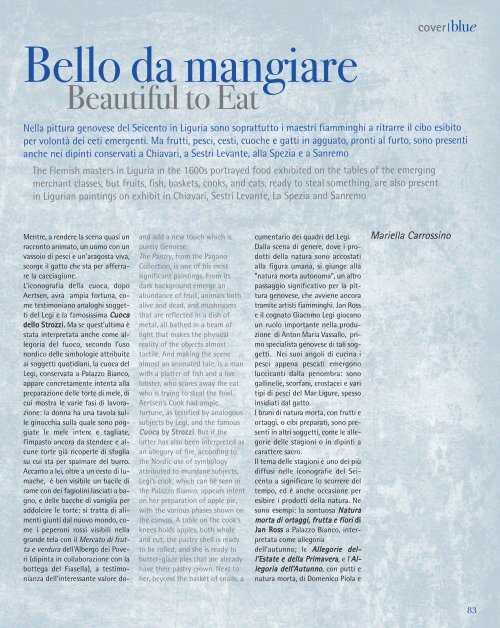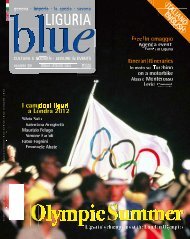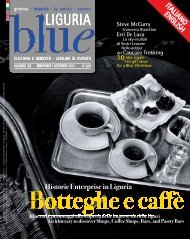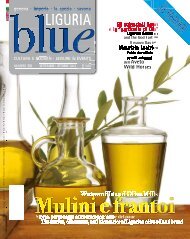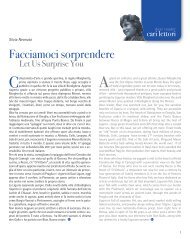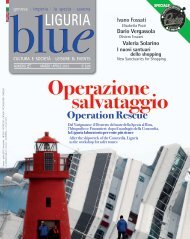cover - Blue Liguria - Sagep
cover - Blue Liguria - Sagep
cover - Blue Liguria - Sagep
Create successful ePaper yourself
Turn your PDF publications into a flip-book with our unique Google optimized e-Paper software.
Bello da mangiare<br />
Beautiful to Eat<br />
Nella pittura genovese del Seicento in <strong>Liguria</strong> sono soprattutto i maestri fiamminghi a ritrarre il cibo esibito<br />
per volontà dei ceti emergenti. Ma frutti, pesci, cesti, cuoche e gatti in agguato, pronti al furto, sono presenti<br />
anche nei dipinti conservati a Chiavari, a Sestri Levante, alla Spezia e a Sanremo<br />
The Flemish masters in <strong>Liguria</strong> in the 1600s portrayed food exhibited on the tables of the emerging<br />
merchant classes, but fruits, fish, baskets, cooks, and cats, ready to steal something, are also present<br />
in <strong>Liguria</strong>n paintings on exhibit in Chiavari, Sestri Levante, La Spezia and Sanremo<br />
Mentre, a rendere la scena quasi un<br />
racconto animato, un uomo con un<br />
vassoio di pesci e un’aragosta viva,<br />
scorge il gatto che sta per afferrare<br />
la cacciagione.<br />
L’iconografia della cuoca, dopo<br />
Aertsen, avrà ampia fortuna, come<br />
testimoniano analoghi soggetti<br />
del Legi e la famosissima CCuuooccaa<br />
dello Strozzi. Ma se quest’ultima è<br />
stata interpretata anche come allegoria<br />
del fuoco, secondo l’uso<br />
nordico delle simbologie attribuite<br />
ai soggetti quotidiani, la cuoca del<br />
Legi, conservata a Palazzo Bianco,<br />
appare concretamente intenta alla<br />
preparazione delle torte di mele, di<br />
cui mostra le varie fasi di lavorazione:<br />
la donna ha una tavola sulle<br />
ginocchia sulla quale sono poggiate<br />
le mele intere e tagliate,<br />
l’impasto ancora da stendere e alcune<br />
torte già ricoperte di sfoglia<br />
su cui sta per spalmare del burro.<br />
Accanto a lei, oltre a un cesto di lumache,<br />
è ben visibile un bacile di<br />
rame con dei fagiolini lasciati a bagno,<br />
e delle bacche di vaniglia per<br />
addolcire le torte: si tratta di alimenti<br />
giunti dal nuovo mondo, come<br />
i peperoni rossi visibili nella<br />
grande tela con il Mercato di frutta<br />
e verdura dell’Albergo dei Poveri<br />
(dipinta in collaborazione con la<br />
bottega del Fiasella), a testimonianza<br />
dell’interessante valore do-<br />
and add a new touch which is<br />
purely Genoese.<br />
The Pantry, from the Pagano<br />
Collection, is one of his most<br />
significant paintings. From its<br />
dark background emerge an<br />
abundance of fruit, animals both<br />
alive and dead, and mushrooms<br />
that are reflected in a dish of<br />
metal, all bathed in a beam of<br />
light that makes the physical<br />
reality of the objects almost<br />
tactile. And making the scene<br />
almost an animated tale, is a man<br />
with a platter of fish and a live<br />
lobster, who scares away the cat<br />
who is trying to steal the fowl.<br />
Aertsen’s Cook had ample<br />
fortune, as testified by analogous<br />
subjects by Legi, and the famous<br />
CCuuooccaa by Strozzi. But if the<br />
latter has also been interpreted as<br />
an allegory of fire, according to<br />
the Nordic use of symbology<br />
attributed to mundane subjects,<br />
Legi’s cook, which can be seen in<br />
the Palazzo Bianco, appears intent<br />
on her preparation of apple pie,<br />
with the various phases shown on<br />
the canvas. A table on the cook’s<br />
knees holds apples, both whole<br />
and cut; the pastry shell is ready<br />
to be rolled; and she is ready to<br />
butter-glaze pies that are already<br />
have their pastry crown. Next to<br />
her, beyond the basket of snails, a<br />
cumentario dei quadri del Legi.<br />
Dalla scena di genere, dove i prodotti<br />
della natura sono accostati<br />
alla figura umana, si giunge alla<br />
“natura morta autonoma”, un altro<br />
passaggio significativo per la pittura<br />
genovese, che avviene ancora<br />
tramite artisti fiamminghi. Jan Ross<br />
e il cognato Giacomo Legi giocano<br />
un ruolo importante nella produzione<br />
di Anton Maria Vassallo, primo<br />
specialista genovese di tali soggetti.<br />
Nei suoi angoli di cucina i<br />
pesci appena pescati emergono<br />
luccicanti dalla penombra: sono<br />
gallinelle, scorfani, crostacei e vari<br />
tipi di pesci del Mar Ligure, spesso<br />
insidiati dal gatto.<br />
I brani di natura morta, con frutti e<br />
ortaggi, o cibi preparati, sono presenti<br />
in altri soggetti, come le allegorie<br />
delle stagioni o in dipinti a<br />
carattere sacro.<br />
Il tema delle stagioni è uno dei più<br />
diffusi nelle iconografie del Seicento<br />
a significare lo scorrere del<br />
tempo, ed è anche occasione per<br />
esibire i prodotti della natura. Ne<br />
sono esempi: la sontuosa NNaattuurraa<br />
mmoorrttaa ddii oorrttaaggggii,, ffrruuttttaa ee ffiioorrii di<br />
Jan Ross a Palazzo Bianco, interpretata<br />
come allegoria<br />
dell’autunno; le AAlllleeggoorriiee ddeell-ll’’EEssttaattee<br />
ee ddeellllaa PPrriimmaavveerraa, e l’AAll-lleeggoorriiaa<br />
ddeellll’’AAuuttuunnnnoo, con putti e<br />
natura morta, di Domenico Piola e<br />
<strong>cover</strong><br />
Mariella Carrossino<br />
blue<br />
83


